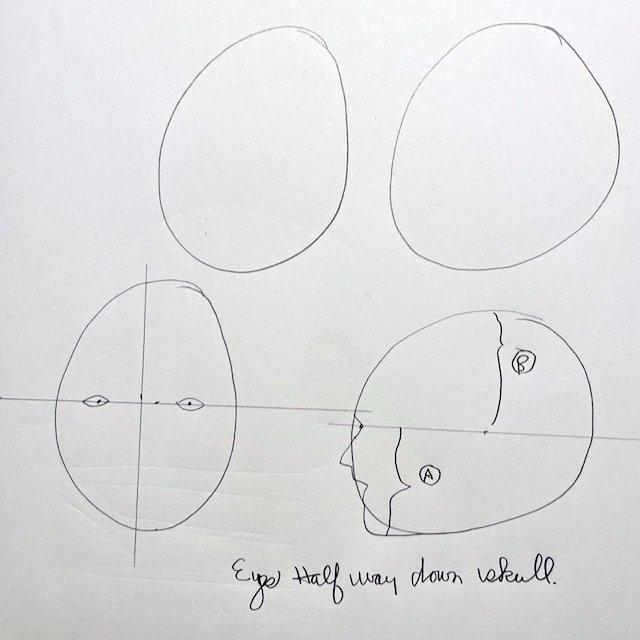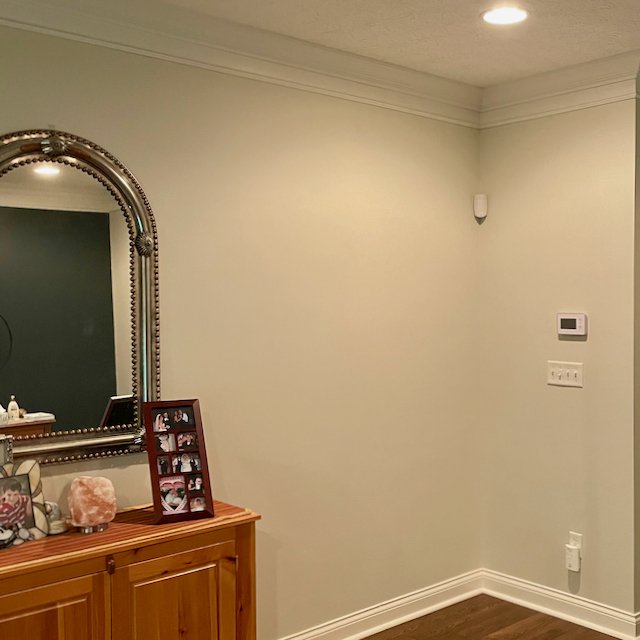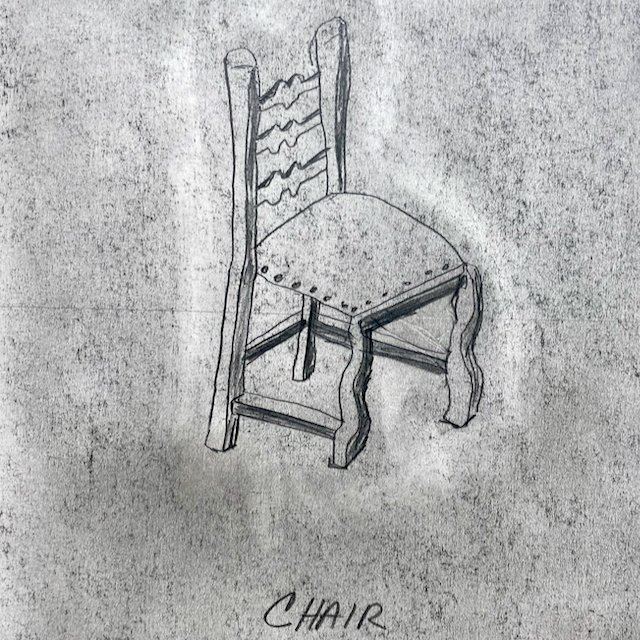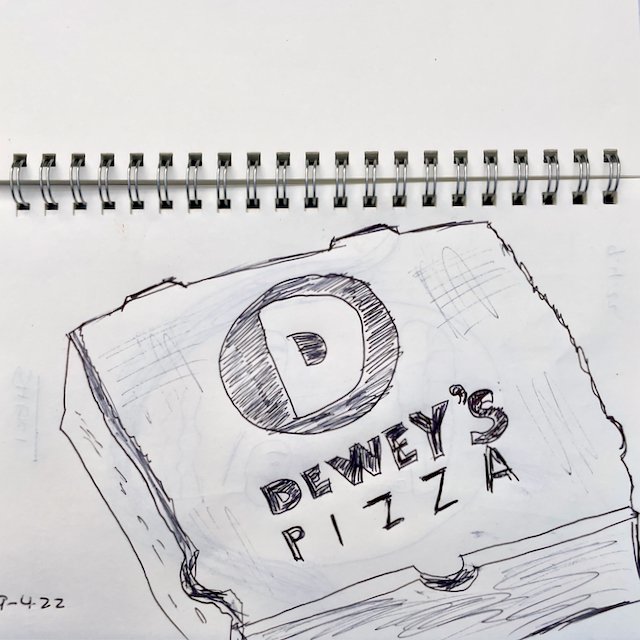Morning Coffee
Here is a sketch of my morning coffee. I am still working on the perspective of the top. Still too round and doesn’t give the depth of the angle. I now realize this is my left brain telling me what I am seeing and what I should draw. Next time I need to use the picture plane to get it into a two-dimensional view.
Live Portrait Model
Drawing a two-dimensional portrait out of a book is tough, but a three-dimensional model is even more challenging.
You have the left brain interfering and dictating what you should see and draw, and your right brain trying to draw what you see. Putting all the learnings into practice is challenging. Therefore, this is a learned skill, not a God-given talent you have or don’t have.
It is tough, but I am continuing to work through it. I think I have made a 1% improvement from yesterday’s drawing to today.
Madame X
Today's drawing is day two of developing my portrait skills. Today was a warm-up exercise of drawing John Singer Sargent's Madam X. Focusing on the proportions and how the eyes, ears, and head proportions line up.
Putting aside what you see, people are even more alike than you think. There are infinite unique faces and features, but almost everyone is the same in many respects. For example, the eyes are halfway between the top of the skull and the chin, and the back of the eye to the back of the ear is the same distance as the front of the eye to the top of the head. In this crazy world, another example of what we have in common.
Learning the isosceles triangle of the head, eyes, and ears is fantastic. Progressing 1% a day.
Eyes Have It
After a break for health reasons, I am back working on and enjoying drawing. The next chapter of my Drawing on the Right Side of the Brain book course is portraits. The first section deals with proportions and precisely where the eyes fall o the skull.
Interestingly the eyes fall equidistant from the top of the head to the bottom of the chin. So even though our eyes (left brain) challenge this thought, it is accurate.
Today’s sketch is a basic shell with the axis and horizon drawn in on both the front and profile views of the head. I was getting comfortable with the placement of the eyes.
The Office Corner
Today’s sketch focuses again on the perspective skill. Using the picture plane, I drew my Basic Unit (the Formula One photography on the left of the corner) on my picture plane and then transferred that to my shaded paper.
From there, I drew the remaining elements. I’m happy with how I could draw the view to scale and didn’t run out of space on the page. Most everything in the view was captured to scale.
1% improvement!
The Corner
Today’s sketch focused on sighting the angles in a room corner with just a pencil. First, I drew the central vertical line, which always remains vertical regardless of the viewing angle. And then, using my pencil, I visually saw the angle for the floor and ceiling with the vertical corner.
Getting good and working these angles and tricking my left brain, which is convinced the lines are straight.
Focused on constant improvement day by day,
Vanishing Point down the Hallway
The vanishing point is a crucial tenant of drawing with the proper perspective. Understanding how the vanishing point works and how the straight lines converge down from above to the vanishing point and up to the vanishing point from below.
This plays havoc with your left brain because it knows these are straight lines. So forcing your left brain to give up and letting your right side brain take over and draw to the vanishing point is vital.
I have some work to do.
Apples on the Counter
Although a simple setup, today’s sketch offers the ability to so depth with a three-dimensional object and volume by showing the shadows with the paper towel under the apples and shadows from the apples.
I need to continue to work on all three, and utilizing a simple countertop setup like this will always give me the opportunity.
Studies of Arms and Legs
This sketch combined negative spaces and an upside-down drawing. Reinforced practice is good. Using Rubens’ sketch “Studies of Arms and Legs,” I utilized both techniques. I think it went well. Not an exact reproduction, but looks good.
I am still working through the skills and drills from Betty Edwards’ Drawing on the Right Side of the Brain.
Dining Room Chair
This sketch was focused on negative spaces and developing the skills to see negative spaces. I picked what Betty Edwards in Drawing on the Right Side of the Brain calls a basic unit. I used the square on the bottom of the chair as my basic unit.
Using my picture plane, I framed the chair and drew the basic unit square on the plane. Then, I could transfer the basic unit’s location to my page using the grid lines. Finally, correctly placing the basic unit on the paper, I completed the rest of the chair.
I’m happy with the drawing and, more importantly, pleased with the progress I am making. Again, small steps focused on incremental improvement.
Enjoy!
Pizza Box
Originally I sketched my wife at dinner. But unfortunately, I didn’t get clearance to post that drawing! So I drew the take-home pizza box—a simple box with the logo. Good sketch.
It pays to take a sketchbook with you wherever you go. I keep an inexpensive book in the car for just these occasions.
Let me know what you think in the comments below.
Three Potatoes
Today I wanted to try a live scene with directional lighting. So I set up three potatoes and my flashlight to provide specific directional lighting. I’ve included the original setup and my drawing. I am still working on getting the roundness of the potatoes, the surface texture, and the shadows, all with a fountain pen.
What do you think? Let me know in the comments below.
Backyard Flowers
This backyard flowers sketch was the first drawing I have done from a picture. I enjoyed the experience knowing it was from an image I captured in my backyard. A bit of farm to table. I enjoyed taking a bit of creative license with the vision and not focusing on recreating the image.
Also, my most crucial fan and critic could easily recognize the sketch as flowers. For some reason, that matters!
The Chair
Today’s sketch was a tough one. Trying to sketch the chair while getting the perspective and depth was hard. I tried to use the picture plane but couldn’t keep it still. I tried to focus on the negative space but couldn’t get that clear. Just an overall tough sketch today.
I’m not discouraged at all. This drawing shows where I need to put the work in. Nothing comes easy!
Picture Plane – another hand
Practice, practice, practice. I can focus on getting confident with my lines, angles, and details. Using the picture plane allows me to focus on seeing my three-dimension hand in two dimensions. I can disconnect from the hand and fingers and focus on the lines, space, and negative space.
Good practice sketch.
Picture Plane Practice - Hand
This is another hand sketch with the picture plane. Practice brings repetition, and I enjoy focusing on the lines, angles, and negative space, not that I am drawing a hand. It works as I focus on using my right brain and excusing my left dominant brain.
Enjoy
Hand–Modified Pure Contour Drawing
With today’s assignment, we used the hand from the picture plane and essentially drew that image onto sketching paper. I shaded the paper using charcoal and then drew the hand off the original drawing on the picture plane.
This was the first time using charcoal and another skill that I could develop.
It adds dimensionality to the drawing. Also, the details of the lines and shadows of my hands are seen.
A great drawing that I am happy with.
Fun in the Kitchen
Sunday’s sketches were from the book How to Draw and Write in Fountain Pen. I captured a bunch of kitchen-themed images with my fountain pen—an excellent way to spend a Sunday afternoon doodling and practicing.
I hope you enjoy it!
The Hand on the Picture Plane
Today’s assignment was to draw my hand in foreshortened view using a glass picture plane. This technique/learning tool was created back in the 1400s. This tool helps you see and draw a three-dimensional item on a two-dimensional plane.
It is unbelievably easy to trace my hand on the glass. It was interesting to me how the glass eliminated the stress and angst of trying to capture the depth of my hand. Instead, I focused on the lines and outside map of my hand and watch—a great learning experience.
I picked up a discount picture frame and a few cheap mats at the craft store—an inexpensive, practical glass picture plane.
Pure Contour Drawing - The Hand
Pure Contour Drawing – The Hand
An essential drill to help people develop their drawing skills was introduced in 1941 by Kimon Nicolaides; contour drawing. This drill helps build your skill in seeing the edges and contours of your subject.
In Drawing on the Right Side of the Brain, Betty Edwards modified the contour drawing into the pure contour drawing. Her drill has you looking at a subject, in this case, my left hand, and placing my other hand and pencil on the paper. I started the timer for five minutes and ONLY looked at my left hand. I followed the crevices and contours of my hand with my eyes and allowed my drawing hand to “follow” my eyes on the page.
Your outcome is a record of your perceptions of the creases in your palm, not a beautiful sketch of your hand.


























